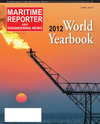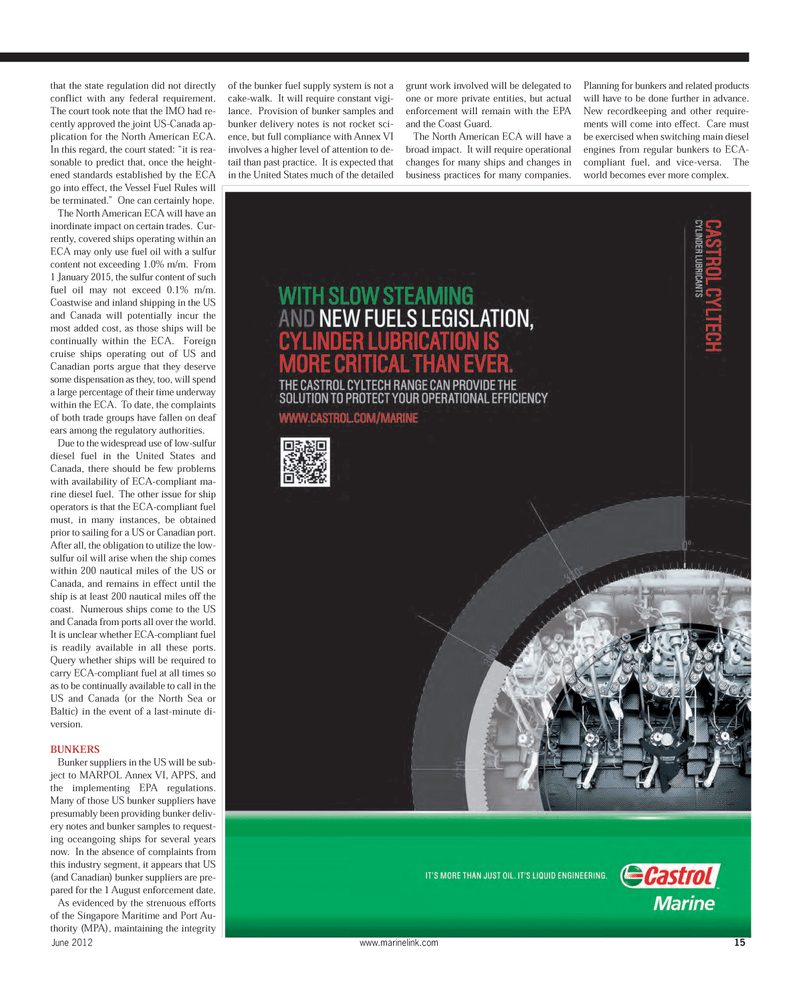
Page 15: of Maritime Reporter Magazine (June 2012)
Annual World Yearbook
Read this page in Pdf, Flash or Html5 edition of June 2012 Maritime Reporter Magazine
that the state regulation did not directly conflict with any federal requirement. The court took note that the IMO had re-cently approved the joint US-Canada ap- plication for the North American ECA. In this regard, the court stated: ?it is rea- sonable to predict that, once the height-ened standards established by the ECAgo into effect, the Vessel Fuel Rules will be terminated.? One can certainly hope. The North American ECA will have an inordinate impact on certain trades. Cur- rently, covered ships operating within an ECA may only use fuel oil with a sulfurcontent not exceeding 1.0% m/m. From 1 January 2015, the sulfur content of suchfuel oil may not exceed 0.1% m/m. Coastwise and inland shipping in the USand Canada will potentially incur themost added cost, as those ships will becontinually within the ECA. Foreign cruise ships operating out of US andCanadian ports argue that they deserve some dispensation as they, too, will spend a large percentage of their time underway within the ECA. To date, the complaints of both trade groups have fallen on deaf ears among the regulatory authorities. Due to the widespread use of low-sulfur diesel fuel in the United States andCanada, there should be few problems with availability of ECA-compliant ma- rine diesel fuel. The other issue for ship operators is that the ECA-compliant fuelmust, in many instances, be obtained prior to sailing for a US or Canadian port.After all, the obligation to utilize the low- sulfur oil will arise when the ship comeswithin 200 nautical miles of the US orCanada, and remains in effect until the ship is at least 200 nautical miles off the coast. Numerous ships come to the USand Canada from ports all over the world. It is unclear whether ECA-compliant fuelis readily available in all these ports. Query whether ships will be required tocarry ECA-compliant fuel at all times soas to be continually available to call in the US and Canada (or the North Sea orBaltic) in the event of a last-minute di- version. BUNKERS Bunker suppliers in the US will be sub- ject to MARPOL Annex VI, APPS, and the implementing EPA regulations. Many of those US bunker suppliers have presumably been providing bunker deliv- ery notes and bunker samples to request- ing oceangoing ships for several years now. In the absence of complaints from this industry segment, it appears that US (and Canadian) bunker suppliers are pre- pared for the 1 August enforcement date. As evidenced by the strenuous efforts of the Singapore Maritime and Port Au- thority (MPA), maintaining the integrity of the bunker fuel supply system is not a cake-walk. It will require constant vigi- lance. Provision of bunker samples and bunker delivery notes is not rocket sci- ence, but full compliance with Annex VI involves a higher level of attention to de- tail than past practice. It is expected that in the United States much of the detailedgrunt work involved will be delegated to one or more private entities, but actual enforcement will remain with the EPA and the Coast Guard.The North American ECA will have a broad impact. It will require operationalchanges for many ships and changes in business practices for many companies. Planning for bunkers and related products will have to be done further in advance. New recordkeeping and other require- ments will come into effect. Care must be exercised when switching main diesel engines from regular bunkers to ECA- compliant fuel, and vice-versa. The world becomes ever more complex. June 2012www.marinelink.com 15MR June12 # 2 (9-16):MR Template 6/11/2012 9:16 AM Page 15

 14
14

 16
16
